3 Tips for Removing Odors After a Flood
4/17/2022 (Permalink)
Tips To Remove Odors After a Flood
Water damage in buildings is a very common problem and one that can be difficult to resolve. Not only does the water itself cause property damage, but it can lead to mold growth, odors and other problems. If you are noticing odors in your building after a flood, these three tips can help you remove them.
1. Clean and Dry Your Carpets
Carpeted areas can be particularly challenging when damaged by flood water. The water can soak into the carpet pad and cause mold. It can also leave behind stains and smells. The first step is to completely dry out your carpet. You may need the assistance of a water restoration company in St. Charles, IL, to do this. Once your carpet is dry, thoroughly clean it, but do not use too much moisture, because this could lead to a new mold problem. Try sprinkling baking soda or a commercial carpet deodorizer on the carpet to absorb odors.
2. Throw Out Contents That Can Not Be Dried Out
Some types of properties, such as carpets, upholstered furniture, insulation and paper files are difficult to completely dry out, which can lead to mold growth. Anything you have that you can not promptly dry out may need to be discarded to prevent future problems such as mold and bad smells.
3. Ventilate and Deodorize the Building
One of the first things to do after sewage loss or flooding is to open as many doors and windows as possible. This helps to air out the building and aid in the drying process. You can help this process along by using a space heater, box fan or overhead fan. Using a commercial deodorizer may also help with eliminating odors.
Flood damage can cause mold growth and other issues that can lead to unpleasant odors in your building. These three steps can help you eliminate this problem before it gets worse.





 24/7 Emergency Service
24/7 Emergency Service
